| Article ID | Journal | Published Year | Pages | File Type |
|---|---|---|---|---|
| 4293127 | Journal of the American College of Surgeons | 2013 | 12 Pages |
BackgroundValue is an economic utility defined by quality and cost, with the maximum benefit achieved by improving quality and reducing cost simultaneously. Health care systems are using value-based analysis to identify the best practices (BPs) that accomplish this goal.Study DesignWe chose a clinical condition, deep venous thrombophlebitis (DVT) to test this hypothesis by identifying the BPs available in the literature; determining the usual practice for DVT prophylaxis at each of 8 hospitals (ie, community, tertiary, and a university hospital) in an integrated system; measuring clinical outcomes (mortality and morbidity) for each hospital; determining cost for each treatment algorithm in each hospital; and measuring the savings opportunity if a single BP was used by all of the hospitals.ResultsThe literature suggests that the BPs for DVT prophylaxis consist of sequential compression devices for short-stay procedures; unfractionated heparin for inpatient procedures, and low molecular weight heparin for thrombotic events. Four of the hospitals were using these BPs; the others relied on sequential compression devices and low molecular weight heparin for prophylaxis. Outcomes were identical and value-based analysis suggested a savings opportunity of nearly $4 million if a single BP was adopted.ConclusionsThere were substantial variations in the type of DVT prophylaxis used by the hospitals with no difference in outcomes. A single BP increased value and resulted in savings of $1.5 million, with a savings opportunity of nearly $4 million.
